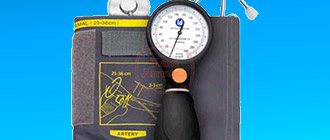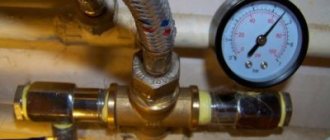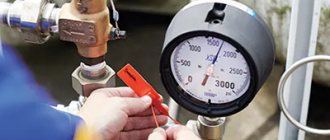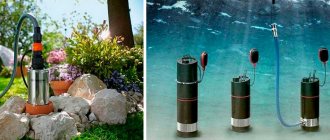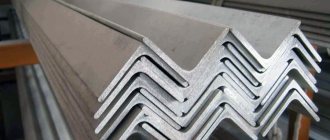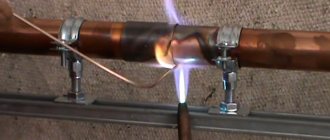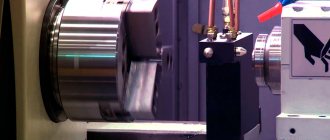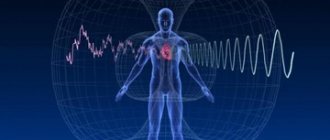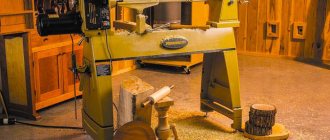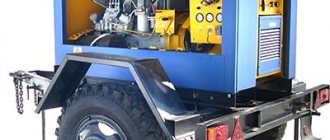All devices that measure pressure are classified according to several criteria:
By type of pressure measured: pressure gauges, vacuum gauges, pressure and vacuum gauges, pressure gauges, micromanometers, draft gauges, draft pressure gauges, barometers, differential pressure gauges.
Pressure gauges are devices used to measure excess or absolute pressure (pressure difference). The “zero” of the excess pressure gauge is at the level of atmospheric air pressure.
Vacuum gauges are used to measure the pressure of rarefied gases.
A pressure and vacuum gauge allows you to determine excess pressure and rarefaction of a gas.
Pressure meters measure a small excess pressure (no more than 40 kPa), and draft meters measure a small vacuum pressure.
Differential pressure gauges determine the pressure difference at two points.
Micromanometers are differential pressure gauges for determining small pressure differences.
Barometers determine atmospheric air pressure.
According to the principle of operation: liquid, deformation (spring, bellows, membrane), deadweight, electrical and other devices.
Liquid pressure gauges consist of communicating vessels, the pressure is determined by one or several levels. With deformation pressure gauges, pressure is determined by the deformation or elastic force of the deforming element - spring, membrane, bellows. In deadweight piston pressure gauges, the desired pressure value is determined by balancing the mass of the weights and the piston. Electric pressure gauges operate on primary pressure transducers.
Purpose: general technical for measuring pressure in technological processes and reference for verification.
By accuracy class: from 0.4 to 4.0. This indicator characterizes the measurement error of the device.
According to the characteristics of the measured medium: general technical, corrosion-resistant, vibration-resistant, special, oxygen, gas.
Special pressure gauges are used for viscous and crystallizing substances, as well as substances that contain solid particles.
In addition to the above, pressure measuring instruments differ in the limit (range) of measurements, the degree of protection from water (eight degrees), the type of protection from external objects (six degrees), the degree of resistance to vibration, the degree of resistance to humidity and temperature (11 groups ).
Pressure gauges and pressure-vacuum gauges are designed to withstand short-term overload.
The dial of the device is marked with scale markings, units of pressure measurement, minus sign for vacuum pressure, mounting position of the device, accuracy class, name/designation of the medium, State Register sign, trademark of the manufacturer.
See examples of the use of electrical contact pressure gauges in electrical circuits here: Automation of pumps and pumping stations
In many technological processes, pressure is one of the main parameters that determine their progress. These include: pressure in autoclaves and steaming chambers, air pressure in process pipelines, etc.
Determination of pressure value
Pressure
is a quantity characterizing the action of a force per unit surface.
When determining the pressure value, it is customary to distinguish between absolute, atmospheric, excess and vacuum pressure.
Absolute pressure (p a )
- this is the pressure inside any system under which a gas, vapor or liquid is located, measured from absolute zero.
Atmospheric pressure (p in )
created by the mass of the air column of the earth's atmosphere. It has a variable value, depending on the altitude of the area above sea level, geographic latitude and meteorological conditions.
Overpressure
determined by the difference between absolute pressure (pa) and atmospheric pressure (pv):
Read also: Mixer for mortar for drill
Vacuum (vacuum)
is a state of gas in which its pressure is less than atmospheric. Quantitatively, vacuum pressure is determined by the difference between atmospheric pressure and absolute pressure inside the vacuum system:
When measuring pressure in moving media, the concept of pressure refers to static and dynamic pressure.
Static pressure ( pst )
– this is pressure depending on the potential energy reserve of a gas or liquid medium; determined by static pressure. It can be excess or vacuum, in a particular case it can be equal to atmospheric.
Dynamic pressure ( pd )
– this is the pressure caused by the speed of the gas or liquid flow.
Total pressure (p p )
moving medium consists of static (рst) and dynamic (рд) pressures:
Description of atmospheric pressure measuring instruments
06/19/2015
Air pressure varies widely. If it is more than 760 millimeters of mercury, then it is considered elevated
, if less, then
reduced
.
Observations of changes in atmospheric pressure make it possible to predict the weather. For example, when pressure increases in winter, the weather becomes frostier, and in summer it becomes hot.
Low atmospheric pressure contributes to cloudiness and precipitation.
Therefore, constantly knowing the value of atmospheric pressure and monitoring its changes is necessary not only for scientists and doctors, but for all of us.
Atmosphere pressure
Atmospheric pressure is measured in millimeters of mercury, as well as in Pascals and hectoPascals. Normal blood pressure is considered to be 760 mmHg. Art. (1013.25 hPa) .
Atmospheric pressure generally changes with changes in weather conditions. Often, pressure drops before inclement weather and rises before good weather. Keeping records of pressure changes allows you to determine the movement of cyclones and the direction of winds.
A change in characteristic pressure often does not affect the well-being of a person living for a long time in a certain area. In cases where non-periodic fluctuations in atmospheric pressure occur, even healthy people experience headaches, decreased performance and a feeling of heaviness in the body.
Changes in atmospheric pressure also affect many technological processes.
For example, when processing petroleum products, where pressure is one of the main controlled technical parameters; bakery production, where pressure readings greatly affect the moisture content of semi-finished dough products; in the aviation industry this is a very important parameter that affects the terms and conditions of operation.
Instruments for measuring atmospheric pressure
Today, there are several types of barometers that are used to measure air pressure:
- Mercury siphon barometer - represents a Y-shaped tube filled with mercury with an open and sealed end.
- Mercury cup barometer - consists of a vertical tube filled with mercury, the upper end of which is sealed, and the lower end is in a special cup with mercury.
- An aneroid barometer is an airless metal box with wavy walls.
- A barograph is a self-recording instrument that is used to monitor barometric pressure at certain periods of time.
- An electronic barometer is a digital device that operates on the principle of a conventional aneroid or on the principle of measuring air pressure on a sensitive crystal.
Mercury barometers are more accurate and reliable compared to aneroids; they are used to check the operation of other types of barometers. The height of pressure in them is determined by the height of the mercury column. Meteorological stations are equipped with cup barometers.
Measuring atmospheric pressure using a thermohygrometer
Atmospheric pressure is measured not only using various types of barometers, but also with such universal digital instruments as thermohygrometers.
Despite the fact that the main task of these devices is to determine relative humidity and temperature, they also do an excellent job of measuring air pressure, showing the most accurate values.
Therefore, such multifunctional devices are much more profitable to purchase than outdated barometers and psychrometers.
JSC "EXIS" brings to your attention a huge range of electronic pressure meters and other high-quality control and measuring instruments and always at affordable prices.
In particular, in our company you can purchase the following models of thermohygrometers:
- Thermohygrometer IVTM-7 M 2-D-V
. The device, in addition to measuring and recording temperature and relative humidity of air and other non-aggressive gases, measures atmospheric pressure in millimeters of mercury and hPa, can record data in non-volatile memory, recalculate measurement results into various units (percentage of relative humidity, g/m3), carry out simultaneous indication of measured values. IVTM-7 M 2-D-V has a high degree of dust and moisture protection (IP65), making it possible to use it in rooms with high humidity. - Thermohygrometer IVTM-7 K-1
. The device measures atmospheric pressure in kPa, can recalculate the values of various humidity units, carry out simultaneous indication of measured values, record data on microSD, it is possible to connect various types of primary transducers. - Thermohygrometer IVTM-7 R-03-I-D
. The device is equipped with a liquid crystal indicator designed for visual monitoring of relative humidity, temperature and pressure values. It has small dimensions and an ergonomic body. - Thermohygrometer IVTM-7 M 6-D (in an ergonomic housing).
The device measures atmospheric pressure in kPa, can record data on a non-volatile memory card, recalculate measurement results into various units, and simultaneously display the measured values. It has an ergonomic body and a large and convenient display. - Thermohygrometer IVTM-7 M 3-D-V
. The device, in addition to measuring and recording temperature and relative humidity of air and other non-aggressive gases, measures atmospheric pressure in millimeters of mercury and hPa, can record data in non-volatile memory, recalculate measurement results into various units (percentage of relative humidity, g/m3), carry out simultaneous indication of measured values. Model IVTM-7 M3-D-V is intended for creating a measuring network. The degree of moisture protection of the housing and sensor is IP65, which makes it possible to use it in rooms with high humidity. - Thermohygrometer IVTM-7 M 6-D.
The device measures atmospheric pressure in kPa, can record data on a non-volatile memory card (microSD), recalculate measurement results into various units, and simultaneously display the measured values.
All models of thermohygrometers have a communication interface with a PC via USB, RS-232 and can be mounted on a wall.
Analysis of industrial pressure gauges
1. Instruments for measuring and regulating pressure. Purpose Pressure (p) is a physical scalar quantity measured by the ratio of the force acting perpendicular to the surface area to the area of this surface. Absolute pressure is pressure measured relative to absolute zero pressure or, in other words, absolute vacuum. Relative pressure (in compressor technology - excess pressure) is pressure measured relative to the earth's atmosphere. Devices for measuring total pressures are called pressure gauges; when we are talking about low pressures, the term vacuum gauges is also used, they are designed to measure: - absolute pressure; — excess (relative) pressure; — pressure difference; — vacuum pressure. Depending on their purpose, instruments for measuring pressure are divided into the following main groups: Pressure gauges - for measuring excess pressure. Absolute pressure gauge - for measuring pressure measured from absolute zero. Pressure and vacuum gauges - for measuring vacuum and excess pressure. Vacuum gauges - for measuring vacuum pressure (vacuum). Barometers - for measuring atmospheric pressure. Bar vacuum gauges - for measuring absolute pressure. Differential pressure gauges - for measuring pressure differences. The unit of pressure in the International System is the pascal (1 Pa). 1 Pa is the pressure produced by a force of 1 N acting on a surface of 1 m2 perpendicular to this surface (Appendix 1). Other extra-system units of pressure are also used: 1 at, 1 mm Hg. Art. 1 mmHg Art. — pressure exerted by a column of mercury 1 mm high. 1 atm is the pressure of the air column at sea level (760 mm Hg). The relationship between these units is given in table. 1
The pressure value can be measured from 0 (absolute pressure) or from atmospheric pressure (gauge pressure). If pressure is measured in technical atmospheres, then absolute pressure is designated as ata, and excess pressure as ati, for example, 9 ata, 8 ati. Gas Capacity Units Compressor performance is measured as the volume of gas compressed per unit of time. The basic unit used is cubic meter per minute (m3/min). The units used are l/min. Productivity is usually given either for conditions (gas pressure and temperature) of suction, or for normal conditions (pressure 1 atm., temperature 20 C). In the latter case, the letter “n” is placed in front of the unit of volume (for example, 5 nm3/min). In English-speaking countries, cubic foot per minute (CFM) is used as a unit of productivity. 1 CFM = 28.3168 l/min. = 0.02832 m3/min. 1 m3/min =35.314 CFM. The relationship between these units is given in table. 2 Table of ratios of performance measurement units:
Instruments for measuring and regulating pressure can be divided into: - instruments for measuring and regulating high pressure; — devices for measuring and regulating low pressure. High pressure is pressure more than 1 atm. Low pressure is pressure not exceeding 1 atm. The low pressure range is divided into low, medium, high and ultra-high vacuum (Fig. 1)
According to the principle of operation, all devices for measuring pressure can be divided into liquid, spring, deadweight and with remote transmission of readings. Devices in which the measured pressure is balanced by the weight of a liquid column, and the change in liquid levels in communicating vessels serves as a measure of pressure, are called liquid devices . This group includes cup and U-shaped pressure gauges, differential pressure gauges, etc. Deformation (spring) devices are devices in which the measured pressure is balanced by the elastic forces of a spring, the deformation of which serves as a measure of pressure. This group includes a variety of devices that differ in the type of springs (diaphragms, bellows, pressure tubes). Due to their simplicity of design and ease of use, spring devices are widely used in technology. Types of spring pressure devices: Spring-piston; Spring-diaphragm; Spring-bell; Spring-bellows. Weight-piston devices are devices in which the measured pressure is balanced by the force created by calibrated weights acting on a piston freely moving in the cylinder. Devices with remote transmission of readings include devices that use changes in certain electrical properties of a substance (electrical resistance of conductors, electrical capacitance, the appearance of electrical charges on the surface of crystalline minerals, etc.) under the influence of the measured pressure. Such devices include manganin resistance pressure gauges, piezoelectric pressure gauges using quartz crystals, tourmaline or Rochelle salt, capacitive pressure gauges, ionization pressure gauges, etc. According to the method of measuring pressure, devices are divided into: - mechanical; - electronic. Today there are about 100 mechanical instruments for measuring and regulating pressure, a complete list of instruments is given in Appendix 2. Based on the registration principle, the entire group of pressure gauges is divided into: - direct-acting pressure gauges; — for indirect-acting pressure gauges. Liquid, compressor and deformation pressure gauges are classified as direct-acting pressure gauges. They directly measure gas pressure. Their readings are fundamentally independent of the composition of the gas and can only indirectly depend on temperature. Indirect pressure gauges do not measure pressure itself, but rather some function of it. Their readings depend on the type of gas and its temperature. Accuracy classes According to their metrological purpose, measuring instruments are divided into standard and working. Exemplary measuring instruments are devices intended for verification of other measuring instruments. Working measuring instruments are all measuring instruments used for direct measurements. The degree of accuracy of the instruments formed the basis for their division into classes. The accuracy class of measuring instruments is characterized by the level of permissible error. Accuracy class is a value characterizing the main permissible reduced error of the device. It expresses as a percentage the ratio of the greatest permissible absolute error of a device under normal operating conditions to its nominal value. Standard pressure gauges have the following accuracy classes: deadweight pressure gauges - 0.05; 0.2; spring pressure gauges - 00.16; 2.5; 0.4. Working pressure gauges have accuracy classes - 0.5; 1; 1.5; 2.5; 4. The choice of one or another measurement method depends on the nature of the quantity being measured, the required measurement accuracy and the measuring equipment. No matter how perfect the measuring instruments and measurement methods are, they still provide only approximate values of the measured quantities. Deviations of measurement results from the actual value of the measured quantity are called measurement error. The actual value of the measured quantity is taken to be the value measured by the reference device. The permissible error is the largest error in the instrument reading allowed by the standards. When classifying instruments according to the degree of accuracy, two types of errors are distinguished - basic and additional. The main error of a device is its error under normal conditions, when external unfavorable factors are absent or their influence is minimized. This error is due to imperfections in the design and assembly of the device; its main factors are: friction in the supports of the moving part, inaccuracy of calibration and drawing of the scale. Additional error is the indication error caused by the influence of external conditions on the device when deviating from normal operating conditions, namely: ambient temperature, air humidity, vibration, shaking, etc. The main characteristics also include variations in readings. The variation in the readings of a measuring device is the largest found experimental difference between repeated readings of a measuring device corresponding to the same actual value of the quantity measured by it under constant external conditions. In indicating instruments, variation can be detected by making a series of observations, changing the actual value of the measured value from the smallest to the largest, and then in the reverse order, and noting the instrument readings corresponding to these values. The reason for the variation is friction and backlash of the moving parts of the device mechanism, incomplete elasticity of springs and other parts subject to forces that change their shape or size. The variation is more pronounced in instruments having a mechanism, but it also exists in other instruments, such as liquid thermometers and pressure gauges, where the resistance of the fluid to movement causes a lag in the reading. Methods for measuring pressure are based mainly on balancing the existing forces using a column of liquid or due to the deformation of various types of springs. Distribution of industrial pressure gauges by industry Instruments for measuring and monitoring pressure are widely used in industries such as oil, gas and many others. The distribution of industrial pressure gauges by industry is shown in Fig. 2. Due to certain requirements for pressure gauges in certain industries, such as aircraft manufacturing, the chemical industry, as well as the insignificant use of pressure gauges in industries such as food, energy, and metallurgy, these industries will not be considered in this study. Distribution of industrial pressure gauges by type in industries 1. The following types of pressure gauges are used in the oil industry: - for oil wells; — registering; — general purpose ranges: 0...6 MPa, 0...4 MPa, 0...25 MPa, 0...160 MPa 0...1.0 MPa; 0…6 MPa; 0…40 MPa 0…1.6 MPa; 0…10MPa; …60 MPa 0…2.5 MPa; 0…16 MPa; 0...100 MPa - vibration-resistant. 2. Gas industry: - general purpose; - differential. 3. Automotive industry: - for brake systems: 0...10 MPa - for automobile pumps (casing bore diameter - 44 mm) 0...4 kgf/cm2 0...6 kgf/cm2 - in car pneumatic systems (casing bore diameter - 60 mm) 0 ...6 kgf/cm2 - in tractors: 0...6 kgf/cm2 - general purpose 4. Shipbuilding: - ship 0...100 kgf/cm2 160...600 kgf/cm2 - ship -1...0...1.5...9 kgf/ cm2 - general purpose 5. Water systems - general purpose - vibration-resistant 6. Railway transport - railway 0...6 kgf/cm2 0...10 kgf/cm2 0...16 kgf/cm2 7. Aircraft construction - aviation two-pointer (0...16 kgf/cm2 ) 8. Food industry: - dairy (polyethylsiloxane liquid filler) 0...10 kgf/cm2 (Accuracy class 5) 9. Chemical industry: - ammonia 0...100 kgf/cm2 over 160 kgf/cm2 - corrosive
High pressure gauges (HP) Oil industry 1. Refinery - 30 pcs. [1] Refineries account for an average of 500 units. Ministry of Internal Affairs 30 x 500 = 15,000 pcs. 2. Oil depots - 900 pcs. [1] There are an average of 500 units per oil depot. Ministry of Internal Affairs 900 x 500 = 450,000 pcs. 3. Gas stations - 70,000 pcs. Number of Ministry of Internal Affairs - 10 70 000 x 10 = 700 000 pcs. 4. Fuel trucks (Based on the assumption that one fuel truck serves two gas stations) 70,000/2 = 35,000 pcs. Ministry of Internal Affairs - 2 pcs. 35,000 x 2 = 70,000 Total, the oil industry accounts for an average of 15,000 + 450,000 + 700,000 + 70,000 = 1,235,000 units. Gas industry 1. Automobile gas. [2] Cars - 400,000 Number of Ministry of Internal Affairs - on average 5 units. 400,000 x 5 = 2,000,000 pcs. 2. Gas control points - 100 GRS - 1000 Number of MIA in one GRS - minimum 2 pcs. 100 x 1000 x 2 = 200,000 pcs. 3. AGCS - 230 [3] Ministry of Internal Affairs on average per AGS - 25 pcs. 230 x 25 = 5750 pcs. 4. Household gas equipment gas boilers -250,000 pcs.[4] Ministry of Internal Affairs minimum 2,250,000 x 2 = 500,000 pcs. 5. Devices for gas welding equipment - 500,000 pcs. Ministry of Internal Affairs at least 1 piece. 500,000 x 1 = 500,000 pcs. 6. Tanker trucks (gas) - 108 (Based on the calculation that one tank truck serves 2 gas filling stations) Ministry of Internal Affairs minimum 2,108 x 2 = 316 pcs. In total, the gas industry accounts for an average of 2,000,000 + 200,000 + 5,750 + 500,000 + 316 = 2,706,066 units. Automotive industry 1. Car - 1,164,667 units/year [5] Number of Ministry of Internal Affairs - on average 5 units. 1,164,667 x 5 = 5,823,335 pcs. 2. Equipment for inflating gas station tires - 70,000 AGKS -208 At every second gas station, tire fitting is carried out using special equipment. equipment (70,000 + 208)0.5 = 35,104 Ministry of Internal Affairs - minimum 1,35,104 x 1 = 35,104 pcs. In total, the automotive industry accounts for an average of 5,823,335 + 35,104 = 5,858,439 units. Water systems 1. Boiler rooms - 68,000 pcs. Ministry of Internal Affairs - on average 10 pieces. 68,000 x 10 = 680,000 pcs. Railway transport railway cars - 850,000 trams - 12,500 metro cars - 5791 Locomotives 20,000 pcs. (wear 70%) Ministry of Internal Affairs on average 3 (850,000 + 12,500 + 5791 + 20,000) x 3 = 2,664,873 pcs. For replacement, based on replacement in each transport, 2 pieces. (850,000 + 12,500 + 5,791 + 20,000) x 2 = 1,776,582 pcs. Total railway transport accounts for an average of 2,664,873 + 1,776,582 = 4,441,455 units. According to preliminary estimates, when segmenting the market for pressure measuring devices, it was revealed that the largest number of devices falls on the following segments: 1. in the automotive industry - 5,858,439 units. 2. for railway transport - 4,441,455 pcs. 3. for the gas industry - 2,706,066 units. 4. for the oil industry - 1,235,000 units. 5. for water systems - 680,000 pcs. Checking preliminary data Automotive industry During the study, it was revealed that cars mainly use various sensors* (Table 3), which do not belong to the category of industrial high-pressure pressure gauges. SENSOR - an element of a measuring, signaling, regulating or control device that converts a control value (pressure, temperature, frequency, speed, light intensity, voltage, electric current, etc.) into a signal convenient for measurement, transmission, storage, registration and impact on controlled processes.
In the automotive industry, high-pressure pressure gauges are used to check and adjust fuel supply pressure, as well as pump performance in cars; as a rule, these are control pressure gauges with fittings, hoses and a valve, the pressure gauge scale is up to 6 kgf/cm2. Brake systems use trace pressure gauges. ranges:
Thus, the market capacity of high-pressure pressure gauges in the automotive industry, taking into account the adjustments, will be: 170,408 x 2 = 340,816 (where 170,408 is the annual production of trucks, 2 - MIA) 64,812 x 2 = 129,624 (where 64,812 is the annual production of buses , 2 - Ministry of Internal Affairs) 70,000 x 1 = 70,000 (where 70,000 is the number of gas stations, 1 - Ministry of Internal Affairs) 208 x 1 = 208 (where 208 is the number of gas stations, 1 - Ministry of Internal Affairs) 25,000 x 1 = 25,000 (individual use ) TOTAL: 340,816 + 129,624 + 70,000 + 208 + 25,000 = 565,648 Ministry of Internal Affairs Thus, the preliminary estimate was inflated by 10 times. Car manufacturing Railway transport railway cars - 850,000 pcs. tram - 12,500 pcs. metro car - 5791 pcs. Locomotives 20,000 pcs. (70% wear) Ministry of Internal Affairs on average 3 (12,500 + 5791 + 20,000) x 3 = 114,873 pcs. For replacement, based on replacement in each transport, 2 pieces. (12500 + 5791 + 20,000) x 2 = 76,582 pcs. Total railway transport accounts for an average of 114,873 + 76,582 = 191,455 units. Thus, the preliminary estimate was overestimated by 23 times.
References 1. Doug Harris “Oil refining in Russia and Ukraine” 08/23/2004 2. Vasyukov G.V. Some aspects of ensuring fire safety of storage facilities, maintenance and repair of gas-cylinder vehicles. 2004 3. Publishing House "Oil and Capital" dated July 12, 2005 "Natural gas and automobile" 4. Ponomarev "Russian market of domestic gas boilers" 5. Let's try. Ru dated 12.2004 “Car production in Russia increased by 9.6%” 6. Automotive gas filling compressor stations 7. https://kipovez.nm.ru/poverca/prdavl/obcv.html General information about pressure devices. Characteristics and classification of devices. 8. GOST 2405-88 Pressure gauges, vacuum gauges, pressure and vacuum gauges, pressure gauges, draft gauges and draft pressure gauges. General technical conditions 9. Bulletin of the Accounts Chamber of the Russian Federation No. 8 (80) / 2004 “Data on the number of metro cars for all operating subways in the Russian Federation” 10. Starikovskaya S. M. Physical research methods. Seminar classes. Part 1. Moscow 2001 11. https:// www.lbmvac.ru Table of relationships between the main units of pressure measurement. Appendix 1 Table of standard pressure sizes
Appendix 2 Mechanical instruments for measuring and regulating pressure Vacuum gauges Sensors 1. Height sensors 2. Dynamic pressure sensors 3. Pressure sensors for limiting (extreme) conditions 4. Miniature and subminiature pressure sensors 5. Programmable pressure sensors 6. Pressure sensors with data output in the form graphic curve 7. Pressure sensors with output signal amplification 8. Pressure sensors with high-speed, instantaneous indication 9. Sensors with extrusion pressure indication 10. Compression and extension sensors 11. Gas and oxygen pressure reduction sensors 12. Reference sensors for calibrating pressure gauges Sensors and primary pressure transducers 1. Absolute pressure sensors and primary transducers 2. Vacuum pressure sensors and primary transducers 3. Bidirectional (two-way) pressure sensors and primary transducers 4. Differential pressure sensors and primary transducers 5. Liquid pressure sensors and primary transducers 6. Sensors and primary pressure transducers relative (comparative) pressure transducers 7. Sensors and primary transducers of manometric, excess pressure Dampers (absorbers) of pressure fluctuations for pressure gauges Pressure gauges 1. U-shaped and double-jointed pressure gauges for two types of liquids 2. Differential pressure gauges (differential pressure gauges) 3. Pressure gauges for measuring absolute pressure 4. Pressure gauges for measuring positive (excess) pressure 5. Pressure gauges for oil wells 6. Pressure gauges for polymers 7. Pressure gauges for liquefied gases in cylinders 8. Pressure gauges for refrigerants 9. Ship pressure gauges 10. Railway pressure gauges 11. Ionization pressure gauges (ionization vacuum gauges ) 12. Combined pressure gauges for measuring excess pressure and vacuum (pressure and vacuum gauges) 13. Multi-leg pressure gauges 14. Inclined pressure gauges (with an inclined U-shaped tube) 15. Single-leg pressure gauges 16. Illuminated signal and warning pressure gauges 17. Portable pressure gauges 18. Precision pressure gauges 19 Precision pressure gauges for laboratories and the chemical industry 20. Pressure gauges with indication and registration (self-recording) 21. Electrical and electronic pressure gauges 22. Pressure gauges, pressure indicators 23. Manostats, pressure stabilizers 24. Micromanometers Equipment for measuring and monitoring pressure in portable fire extinguishers Equipment for pressure tests Manometric and vacuum signal and warning devices Regulators 1. Recorders, recorders for measuring pressure 2. Pressure regulators 3. Pressure regulators for food industry equipment 4. Manual pressure regulators 5. Pressure regulators with a controlled membrane 6. Electronic pressure regulators 7. Pressure regulators and reducers for air 8. Pressure regulators and reducers for gases 9. Pressure regulators and reducers for liquids Pressure switches for refrigeration units Stands for calibrating pressure gauges, pressure measuring instruments Tubes for pressure gauges Traction meters Diaphragm seals for pressure measuring instruments in liquid aggressive media Pressure gauge protection devices Pressure control devices Gas pressure regulation devices for gas generating units Pressure standards ZAO Medtekhnika 198516, St. Petersburg, Petrodvorets, st. Factory building No. 1 Telephone; fax e-mail
Where to buy air flow pressure meters
You can leave a request or buy differential pressure gauges from our managers by calling, filling out a form on the website or writing by email. We can provide advice on equipment maintenance or select an analogue that meets your requirements. In addition, we provide product warranty service. The SOYUZ-PRIBOR company is the official distributor and dealer of a number of brands and has been operating for more than 25 years! Delivery is carried out throughout Russia.
Automatic devices
The automatic device that measures blood pressure in humans is easy to use, so even a child can use it. This tonometer comes with instructions explaining how to determine blood pressure. Also, some tonometers have an adapter for changing the power supply and a special table that tells you how to find out whether intravascular tension has left the normal limits.
The measuring functions of such a device complement the capabilities of semi-automatic devices, so it is the most accurate and best among all similar devices. This device has cuffs for measuring blood pressure and an electric monitor that allows you to measure blood pressure by pressing just one button.
This type of tonometer is divided into several varieties:
It doesn’t matter how pressure is measured, namely, what automatic device. The goal of each of them sounds the same - to provide the most accurate results. Any automatic electronic device that measures pressure on its own inflates a cuff to measure air pressure. It is located on the shoulder, finger or wrist (depending on the choice of medical equipment designed to record intravascular parameters). Next, the device lowers the cuff and shows the patient the finished result.
Each of these tonometers has an adapter for connecting to an electrical outlet, so by purchasing these pressure meters, you can use them both on a trip, at home, and at a resort.
Device selection
Types of pressure gauges
Modern instrument making offers several types of devices, which are pressure meters in different ranges:
The measuring device is selected taking into account the operating conditions and environment.
This will be a special pressure gauge
for working with air, water, steam, oxygen, ammonia, acetone or gas. The environment can be different, including aggressive, therefore the materials of the devices are designed for such operating conditions. The parameters of the housing, in particular, strength and diameter, are taken into account when choosing if it is to be operated in conditions of vibration or high humidity, in order to prevent damage to the housing from corrosion or mechanical stress.
Functional load
The pressure measuring device is selected depending on the needs of the production process, it must be suitable for the functions and operating conditions. Pressure gauges are divided into the following types
functional load:
The purpose is indicated by the type of device housing, it can be:
Pressure gauges are used in boiler systems, ship and railway equipment. There is a group of devices that can be used in the food industry
production. The material of the measuring device body allows it to meet the service conditions.
Types and design of the device
Depending on the purposes for which the devices are used, they are divided into different types. The most common are spring pressure gauges. They have their advantages:
In a spring pressure gauge, the sensing element is a hollow, curved tube inside. It can have a cross-section in the form of an oval or an ellipsoid. This tube deforms under pressure . It is sealed on one side, and on the other there is a fitting with which the value in the medium is measured. The end of the tube, which is sealed, is connected to the transmission mechanism.
The design of the device is as follows:
A special spring is installed between the teeth of the sector and the gear, which is necessary in order to eliminate backlash.
The measuring scale is presented in Bars or Pascals. The arrow shows the excess pressure of the medium in which the measurement is being taken.
The principle of operation is very simple. The pressure from the medium being measured enters the tube. Under its influence, the tube tries to level out, since the area of the outer and inner surfaces has different sizes. The free end of the tube moves, and the arrow rotates at a certain angle thanks to a transmission mechanism. The measured value and the tube deformation are in a linear relationship. That is why the value that the arrow shows is the pressure of a certain environment.
Mechanical apparatus
A mechanical device for measuring blood pressure bears this name, because it allows you to measure pressure, regardless of external factors. The main thing is that the person is able to inflate the cuff and evaluate the result. This equipment consists of a blood pressure cuff, a pressure gauge (to measure the air pressure inside the cuff) and a bulb.
A mechanical device for non-invasive blood pressure measurement (also called a sphygmomanometer) is used as follows:
- Cuffs for measuring blood pressure are placed on the arm, as high as possible to the shoulder and secured with special Velcro.
- A phonendoscope, similar to a therapeutic device designed to listen to the chest, is placed on the ears. Its other end is placed on the inside of the elbow bend and pressed lightly.
- Next, the arm cuff is inflated using a bulb. Only after this the results and assessment of blood pressure are summed up.
Hydrostatic pressure transducers (hydrostatic level gauges)
These converters are a type of excess pressure sensors, when the latter are used to measure the hydrostatic level of liquids. The transducer actually measures the pressure of the liquid column above it. For use in water utilities and water treatment systems, the range of KIP-Service LLC includes submersible hydrostatic level sensors Hydrobar manufactured by KLAY-INSTRUMENTS BV.
As mentioned above, the SI unit of pressure is “Pascal” (Pa).
In practice, other units of measurement are widely used in industry, besides “Pa” the most common are “bar” (bar), “m.v.s.” (meter of water column) and “kgf/cm²” (kilogram-force per square centimeter), as well as derivatives of these units: “mbar” (millibar), “kPa” (kilopascal), “MPa” (megapascal). Conversion table for popular pressure units
| Units | Pa | kPa | MPa | kgf/cm² | mmHg. | mm water column | bar |
| 1 Pa | 1 | 10–3 | 10–6 | 10.197 16 x 10–6 | 0,007 500 62 | 0,101 971 6 | 0,000 01 |
| 1 kPa | 1 000 | 1 | 10–3 | 0,010 197 16 | 7,500 62 | 101,971 6 | 0,01 |
| 1 MPa | 1 000 000 | 1 000 | 1 | 10,197 16 | 7 500,62 | 101 971,6 | 10 |
| 1 kgf/m2 | 9,806 65 | 9.806 65 x 10–3 | 9.806 65 x 10–6 | 0,000 1 | 0,073 555 9 | 1 | 98.066 5 x 10–6 |
| 1 kgf/cm2 | 98 066,5 | 98,066 5 | 0,098 066 5 | 1 | 735,559 | 10 000 | 0,980 665 |
| 1 mmHg (at 0 °C) | 133,322 4 | 0,133 322 4 | 0,000 133 322 4 | 0,001 359 51 | 1 | 13,595 1 | 0,001 332 24 |
| 1 mm water column (at 0 °C) | 9,806 65 | 9.807 750 x 10–3 | 9.806 65 x 10–6 | 0,000 1 | 0,073 555 9 | 1 | 98.066 5 x 10–6 |
| 1 bar | 100 000 | 100 | 0,1 | 1,019 716 | 750,062 | 10 197,16 | 1 |
Pressure measuring instruments
A tonometer is a medical device for measuring blood pressure (BP) and pulse rate. It is used in healthcare institutions and at home to determine the state of the cardiovascular system. In the absence of problems, blood pressure levels remain stable.
- Small pressure fluctuations up to 20 mm. Hg Art. for systolic or upper value and up to 10 mm. Hg Art. for diastolic or lower value within one day are possible and not dangerous. The reasons for fluctuations are varied: from stress and anxiety to physical activity and heavy meals.
- A prolonged deviation of blood pressure levels from standard values, especially if it goes beyond normal limits, is a possible signal of the development of the disease and requires an early visit to the doctor.
It is important to note that each person has their own optimal blood pressure range to feel their best. Knowing the optimal blood pressure range helps your doctor identify changes in your health.
To determine your pressure range at home, you need to purchase a wrist-mounted device for measuring human blood pressure "Omron". Remember: pressure different from the norm does not work for a healthy person. Even feeling normal in this case is an additional reason to seek medical attention. consultation.
Why measure blood pressure?
Heart attack, stroke, kidney failure, blindness are all precursors to hypertension. And there is only one way to avoid serious complications - to maintain normal blood pressure levels with the help of medications.
Hypertensive patients need a home blood pressure monitor to prevent the risk of possible complications. It is very important to measure blood pressure in a quiet environment to obtain the most accurate data.
The pressure readings of sick and healthy people are influenced not only by external factors and various diseases; age and gender are of particular importance.
According to the data shown in the table, blood pressure increases with age and this is normal, as the body ages and age-related changes occur that provoke disorders.
We remind you! The parameters shown in the table are average values. To determine the exact individual blood pressure level, you must regularly use the Omron home blood pressure monitor and consult a specialist.
Typical elements of devices for measuring pressure levels
The main components of mechanical and semi-automatic blood pressure meters:
- pressure gauge with scale / electronic monitor;
- shoulder cuff (pneumatic chamber in a fabric “sleeve” with fixing Velcro);
- rubber bulb with an adjustable deflation valve for pumping air into the cuff;
- phonendoscope;
- rubber tubes for air supply.
The main components of automatic blood pressure meters:
- electronic unit with display;
- cuff on the shoulder or wrist (pneumatic chamber in a fabric “sleeve” with Velcro fasteners);
- rubber tubes;
- batteries type AA (“finger”) or type AAA (“little finger”);
- network adapter.
Types of Omron tonometers
Mechanical pressure meters CS Medica (CS 106 without phonendoscope / with phonendoscope, CS 105, CS 107, CS 110 Premium).
A mechanical device determines blood pressure by heart beats on the arteries, and the results are displayed on a pressure gauge. Air is pumped into the cuff manually using a special bulb.
Advantages: high reliability, long service life and reasonable price of the pressure meter.
Disadvantages: requires the direct participation of a third party at all stages of measurement, but the human factor introduces some error into the measurement results, the magnitude of which depends on the professionalism of the person measuring.
Automatic shoulder pressure meters (Omron M2 Basic, M2 Basic with adapter, M2 Basic with universal cuff and adapter, Omron M2 Classic, M2 Classic with adapter, M3 Eco, Omron M3 Expert, M3 Comfort, M3 Family, M6 Comfort, Omron M6 , Mit Elite, Mit Elite Plus, M10-IT) Automatic wrist pressure meters (Omron R1, R2, R3 Opti, Omron R5 Prestige)
The operating principle of automatic devices: using a compressor, the device automatically pumps air into the cuff. The result of systolic, diastolic pressure and pulse rate are displayed.
Advantages: accuracy is not affected by the human factor (artificial intelligence pumps air into the cuff, adapting to the individual characteristics of a person), simple use without specific skills.
Disadvantages: error in determining blood pressure in patients with cardiovascular problems (take two or three measurements to avoid inaccuracies); high price, especially of those digital devices for measuring human blood pressure that have the maximum range of consumer functions. The possible error is 3 – 10 mmHg.
Semi-automatic pressure meters (Omron S1, M1 Compact, M1 Eco)
Blood pulsation in the artery is determined automatically, the results are displayed on a liquid crystal display, but the cuff must be filled with air using a rubber bulb.
Advantages: no need to independently calculate pressure readings, all results are in electronic form, excellent functionality at a low cost.
Disadvantages: small errors in blood pressure calculations; require human intervention to pump air into the cuff.
You can buy Omron muscle stimulators with delivery in Moscow and Russia from the official Omron online store in the Russian Federation. Free call within Russia: 8 (800) 333-53-39.
Measurement methods
Blood pressure is measured in two ways:
- Auscultatory (Korotkoff method) – listening to the pulse using a phonendoscope. The method is typical for mechanical devices.
- Oscillometric – the result is immediately displayed on the screen of an automatic device.
However, in both cases the principle of operation of tonometers is the same.
How to measure blood pressure correctly?
When measuring with mechanical instruments, you must follow the instructions:
- The first measurement is carried out in the morning, the second or third measurement is taken in the afternoon and evening (or only in the evening); 1-2 hours after eating and no earlier than 1 hour after smoking or drinking coffee.
- It is advisable to take 2-3 measurements and calculate the average blood pressure value.
- It is correct to take the measurement on your non-working hand (on your left if you are right-handed, and on your right if you are left-handed).
- When applying the cuff, its lower edge should be 2.5 cm above the cubital fossa. The measuring tube extending from the cuff is located in the middle of the elbow.
- The stethoscope should not touch the tonometer tubes. It should be located at the level of the 4th rib or heart.
- The air is pumped vigorously (slow results in pain).
- Air inlet from the cuff should flow slowly - 2 mmHg. per second (the slower the release, the higher the quality of the measurement).
- You should sit at the table, leaning on the back of the chair, with your elbow and forearm on the table so that the cuffs are level with the heart line.
When measuring blood pressure with an automatic device, you should also follow points 1-4 from the instructions above:
- You should sit at the table, calmly leaning on the back of the chair, with your elbow and forearm lying on the table so that the cuff is level with the line of the heart.
- Then press the Star/Stop button and the device will automatically measure your blood pressure, but at this time you should not talk or move.
Blood pressure cuff and its size
The cuffs for the blood pressure meter must be the right size for you; the accuracy of the readings directly depends on this (measure the circumference of your arm above the elbow).
The set of Omron pressure measuring devices includes various cuffs, so it is necessary to check the size and the possibility of connecting additional cuffs.
with mechanical devices:
- Enlarged nylon without fixing ring for shoulder circumference 24-42 cm.
- Nylon with a metal fixing ring for shoulder circumference 24-38 cm.
- Nylon with a metal fixing ring for shoulder circumference from 22-38 cm.
- Enlarged without a fixing bracket for shoulder circumference 22-39 cm.
Mechanical tonometers (except for the CS Medics CS 107 model) have the ability to connect 5 different additional cuffs:
- No. 1, type H (9-14 cm).
- No. 2, type D (13-22 cm).
- Medica No. 3, type P (18-27 cm).
- Medica No. 4, type S (24-42 cm).
- Medica No. 5, type B (34-50 cm).
The Omron Fan-Shaped fan-shaped cuff (22-32 cm) is supplied with semi-automatic However, these tonometers have the ability to connect additional cuffs, which are purchased separately:
- Small + small “pear” (17-22 cm).
- Large for arm circumference (32-42 cm).
included with automatic devices:
- Compression standard CM, repeating the shape of the hand, medium size, (22-32 cm).
- Large CL (32-42 cm).
- Children's CS2 (17-22 cm).
- Universal CW (22-42 cm).
- Innovative Omron Intelli Wrap cuff (22-42 cm).
- Compression, new generation Easy Cuff, repeating the shape of the hand (22-42 cm).
Professional automatic models HBP-1100, HBP-1300 are supplied with two cuffs: a medium compression cuff Omron GS Cuff M (22-32cm) and a large compression cuff Omron GS Cuff L (32-42cm). It is possible to additionally purchase cuffs in the following sizes:
- GS Cuff SS, extra small (12-18 cm).
- GS Cuff S, small (17-22 cm).
- Omron GS Cuff M (22-32 cm).
- GS Cuff XL, extra large (42-50 cm).
Application of differential pressure gauges
Differential pressure is the difference in pressure between set values. Therefore, a differential pressure gauge has two connectors, can measure relative pressure, and the resulting measurement results can be both positive and negative, i.e. show excess or low pressure.
Because of this, it is important to apply the correct pressure to the appropriate connector - the positive connector has excess pressure, and the negative connector has underpressure. This will help obtain more accurate measurement results. If you take measurements in dusty and polluted air, it is better to use a pitot tube. The difference between dynamic and static pressure can be used to determine the air speed in the ventilation duct.
Types of sensors
Thick film sensors on a metal/ceramic membrane
Thick film sensor on a metal/ceramic membrane
This type of strain-resistive sensors is the cheapest, and, as a result, is widely used for the production of inexpensive pressure transducers for non-aggressive media (water, air, steam).
Thick film sensors have the following features:
- The most inexpensive solution;
- Low accuracy - 0.5% or 1%;
- Measuring only high pressure - from 1 bar and above;
- Low overload margin, no more than 2 times;
- No thermal compensation.
Thin film sensors on a steel membrane
Thin-film steel diaphragm sensors
Thin-film steel diaphragm sensors have been developed specifically for use in high-pressure (over 100 bar) transmitters. They provide good linearity and repeatability when operating at high pressures.
Features of thin film sensors:
- Used only for high pressures - from 6 bar;
- Accuracy - no more than 0.25%;
- Low overload margin, no more than 2, sometimes 4 times;
- No thermal compensation.
Ceramic strain gauge sensors
Ceramic strain-resistive sensors
This type of sensors is used for high-precision pressure measurement of media that are not aggressive to the ceramic material (usually Al2O3), except for food products (since the use of a sensor seal is necessary) and viscous media. This type of sensor is used by almost all leading manufacturers of pressure transducers.
Peculiarities:
- Used to measure both low and high pressure;
- High accuracy - up to 0.1%;
- Average resistance to overloads;
- Rough surface (contact with food media is undesirable).
Gauge pressure converters
Figure 1 — General industrial pressure sensor PTE5000
These converters measure the pressure created by any medium relative to atmospheric pressure. This type of pressure transducers is the most common and is used in almost all industries: housing and communal services, energy, water treatment, water purification, heating, air conditioning and ventilation systems, food industry, chemistry, etc.
To measure excess pressure of water, steam, neutral liquids and gases, KIP-Service LLC offers a pressure sensor for general industrial use PTE5000. These sensors are widely used by Russian enterprises to measure water pressure in boiler automation systems, water supply and sewerage systems, housing and communal services and other systems where the low cost of equipment is in the foreground.
Semi-automatic devices
A semi-automatic blood pressure meter is a simplified equipment that allows you to measure the pressure of any person, regardless of education and mental development. Semi-automatic devices are sold in pharmacies at a reasonable price. To use this device you will need:
- Put on the measurement cuff, slightly above the elbow (closer to the shoulder), and secure it.
- Then press the button on the equipment.
- Inflate the air pressure cuff manually using a bulb.
As a result, measuring a person’s blood pressure becomes much easier, because a semi-automatic blood pressure meter deflates the cuff itself and shows ready-made results.
The downside to this blood pressure monitor is that it requires batteries or an electrical connection (depending on the manufacturer and model of blood pressure monitor you choose). Batteries require ongoing financial costs, but otherwise the device will not function, then such intravascular voltage control becomes expensive to use. When purchasing a tonometer that requires a network connection, measuring a person’s blood pressure outside the home will become impossible.
However, some blood pressure measuring devices have a special adapter for the tonometer, which allows you to switch the power from the battery to the mains, and vice versa.
Thanks to this device, you can measure pressure anywhere.
Recommendations for intravascular measurement technology
It doesn’t matter at all whether your blood pressure is measured with a mechanical or automatic tonometer, or what the device for measuring a person’s blood pressure is called: shoulder, finger or wrist. It will be necessary to measure intravascular tension correctly, otherwise even the best devices will show an erroneous result.
- The test is carried out on an empty bladder, because the desire to visit the bathroom provokes intravascular tension.
- Whatever device you use, a sitting position will be required. You need to lean your elbows on the back of the chair and not cross your legs, but place them firmly on the floor.
- Devices for measuring a person’s blood pressure, namely cuffs, are put on the bare arm so that clothing does not create additional compression.
To protect yourself from the progression of intravascular diseases, you should consult with a specialist and find out how blood pressure is measured in your case.
This reduces the risk of complications such as heart attack, stroke and hypertensive crisis. The patient should regularly monitor his own intravascular condition to ensure a competent approach to therapeutic therapy and the return of blood vessels to normal.
